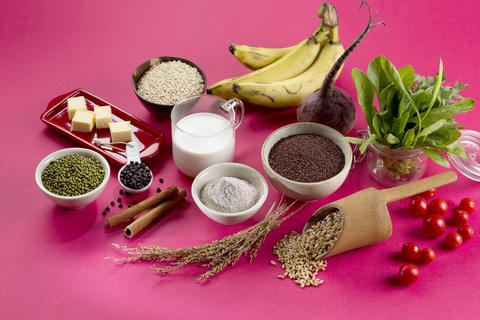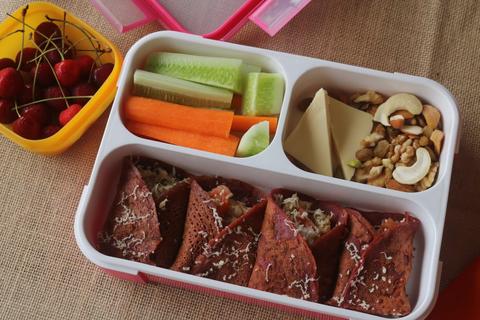by Madhur Ruia
Being healthy is clearly a new trend these days, and is here to stay! Almost everyone chooses to eat brown or multigrain bread over white or maida-based bread. Moreover, salads and soups are becoming a part of our staple diet. So, while adults can pick up healthy eating habits and eat their greens without a fuss, kids are a different story altogether. Kids can be fussy eaters. They turn away from the veggies, the greens, and the brown bread. They are way more attracted to packaged foods, cakes, pastries, chips and burgers.

3 Out of every 4 Indians are overweight
It’s true isn’t it, that this explosion of fast foods, social media, and the digital lifestyle has made our kids adopt the unhealthy lifestyle? Research has it that 3 out of every 4 Indians are overweight. Much worse is the fact that these overweight Indians are primarily in the age group of 26 – 38 years. This alone makes half the population in India overweight. It is vital, therefore, that parents inculcate the value of eating healthy food from the very start with kids to keep them fit and fine and build a habit of healthy living. But kids mirror the habits of their parents, that’s why parents and elders must, in turn, eat healthy nutrition have strong fitness and activity habits to be the best role models.
So, what does healthy eating mean? It means eating a variety of foods that gives you the required nutrients to maintain health, feel good, and have tons of energy. These nutrients include protein, carbohydrates, fat, water, vitamins, and minerals. These varieties of foods should include:
- Fruits
- Dry Fruits
- Vegetables
- Dairies like milk, paneer, egg, and cheese
- Pulses and millets
But the truth of the matter is that kids are picky eaters and it’s hard to get kids around eating all of this ‘boring” healthy food. The taste and textures are not appealing to them.

On account of today’s food culture, they are attracted and addicted to fast food, packaged food, sugary food and everything that looks attractive, or has a catchy mascot or a toy attached to it. For instance, burgers, pizzas, pasta, biscuits, crisps, ice cream, soda, cold drinks, etc.
This erratic and unhealthy eating can pave the way for obesity as these foods make you fat and lazy. In the short run, children can become obese, develop insulin resistance leading to diabetes on the one hand, and frequent colds, cavities and dental caries on the other. If kids don’t eat healthy from the start, they can’t attain the right height, weight, immunity and this, in turn, can cause serious problems in their adulthood, making them more prone to degenerative diseases like diabetes, high blood pressure, cancer, and cardiovascular issues.
Make healthier food choices
Parents these days are making healthier food choices and have started by making home food the preferred choice. Off the shelf food they feel is packaged and not healthy because it is loaded with empty calories, tons of refined sugar, unhealthy trans-fats and preservatives, and outdated packaging modalities. Modalities that destroy food quality.
But times are changing because of technology, and awareness. What’s even better is that the packaged food market in India is slowly but surely adopting the organic and healthy route making “Packaged Food Is Unhealthy” a myth. Yes, you read right. There are several healthy packaged options available for kids that provide excellent nutrition without preservatives. Healthy foods are manufactured and packaged according to the best standards and quality. Some examples are multi-grain biscuits, slices of bread and flour, baked chips, oats, almond milk, zero preservative juices, zero-calorie sauces, and dressings, etc.
Since we are talking about healthy food options for kids, here’s what parents can feed their kids to attain improved and wholesome nutrition.
Early start to eat smart
Parents today have to play an important role in the early habit formation of healthy eating. Its true isn‘t it that children rely on early age programming to face life’s challenges as adults. In other words, if the language of nutrition at home has been one of “let’s eat foods that are cooked at home so we don’t fall sick, or lets eat foods that keep us healthy and energetic, foods like millet, ragi and bajra legumes, nuts and seeds like crunchy almonds and pumpkin.
Make associations with healthy eating and exercise. For instance, on Sundays say that we are going to have a high energy breakfast like, millet dosa with orange and beetroot juice and a huge dollop of almond butter and play family games in the garden, relays, hide and seek and what have you immediately after. This way kids will make an association with home-cooked millet-based nutrition and energetic happy family feelings…Protective feelings that will live with them the way into adulthood.
I want this, I will try this tiffin option!
Focus on other habits like eating only when hungry or at regular intervals, using fruit and nuts or millet granolas snacks and restricting junk eating to about once a week if at all.
Ensure that children eat child-sized portions and not adult-sized portions to induce an important habit of portion control. We all know how damaging it is to let go of portion control. It is one of the key reasons for obesity with adults.
Also, be the role model for your children. If you show your dislike for milk and vegetables or binge eat on weekends or dislike being active then children will end up the same way.
So what are the ways to go intelligent with eating?
1. Choose whole-grain food:
Whole wheat and brown rice are good options. More nutrient density comes from the millet group of grains. These tough grains, unlike others, grow even in times of drought, because they have a way to draw out nutrients deep under several layers of soil. That apart these are filling because they are a rich source of healthy carbohydrates, and tons of minerals and vitamins from the vitamin B group, iron, and fiber. Filling foods like millets prevent sweet cravings and junk cravings.
2. Add colors to your food:
Next includes a lot of color in the diet. Make the 5 a day rule a habit for life for you and your children. Choose from a wide variety of fruits and vegetables- oranges, beetroot, spinach, cherries, purple cabbage, the beans, and cauliflower.
3. Nuts and seeds, please:
Add a good helping of nuts and seeds like almonds, pumpkin, and sunflower for great omega nutrition for improved memory and great skin.
4. Don‘t forget the protein fix:
Don’t forget to include dairy like milk, yogurt, paneer, milkshakes, and if you are a nonvegetarian then the eggs, seafood, and poultry….all in child-sized portions. Include beans dal and legumes, which are powerhouses of nutrition
5. Finally, remember to include all the food groups:
Smart nutrition for kids is about including food that is both calorie and nutrient-dense like millets because children need to grow. A good rule of thumb for fiber intake is age plus 5 gms till children reach puberty.
- Grains like Millets (Ragi, Nachni, Jowar, etc.) and oats should be consumed more as they are a good source of fiber, minerals, protein, and starch
- Pulses like sprouts, deals, chickpeas, lentils provide proteins, carbohydrates, fiber and starch
- Vegetables like leafy greens, tomato, potato, carrot, beet, cucumber, radish, bottle gourd, etc. provide most of the minerals and vitamins
- Dairy products like low fat or skimmed milk, ghee, cheese to an extent, paneer and eggs provide calcium, vitamin A & D, protein and fat
- All the fruits as they provide fiber, vitamins, and minerals
- Seeds and nuts like pumpkin, sunflower and flax seeds, walnut, almond, cashew, pistachio, etc. provide fiber, starch, carbohydrates and fats
The trickiest nutrient out of these are fats, so being smart and aware about them is very important because there are two types i.e. healthy and unhealthy fats. Healthy fats help us stay full, improves memory and lifts our mood.
Healthy fats are unsaturated fats. These can be:
- Monounsaturated – olive oil, avocados, nuts (almonds or pecans), and seeds (pumpkin or sesame)
- Polyunsaturated – flaxseed, walnuts, or omega-3 fatty acids found in fish such as salmon or sardines.
Unhealthy fats are transfats. These can be found in vegetable shortening, margarine, fried foods, baked goods, processed foods made with “partially hydrogenated” vegetable oils and packaged foods such as crackers, cookies, or snack foods.
Healthy food companies are emerging to provide organic wholesome nutrition without the preservatives and harmful trans-fats using today’s technology. Slurrp Farm is one such unit and it is rapidly changing the game through their organic and healthy product range specially made for kids. Slurrp Farm provides the children with the right nutrients and loads of fun. Slurrp Farm was founded by two mothers, Meghana Narayan and Shauravi Malik who aims to provide natural, healthy and tasty food for children. Meghana and Shauravi have put their heart and soul in making healthier millet-based organic cookies, dosas, puffs, pancake and other fun products that they have first tested on their own kids and immediate family.
Have you tried our super easy, yummy and healthy millet dosas, yet? Click here to buy now!
Yes, it is easy! Mums, you can kickstart your kids healthy eating plan the fun way with Slurrp Farm’s wide array of wholesome products for kids. And turn them into their favorite strong superheroes.
|
Madhuri Ruia, an alumnus of the American Academy Of Nutrition, is a well-known Fitness, Posture, Pilates & Nutrition expert. A highly qualified nutritionist by profession, winner by choice, an optimist at heart- Madhuri is a living embodiment of empowerment. |


